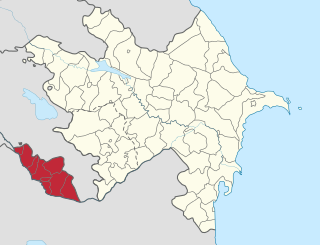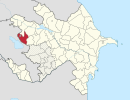
Jēkabpils is a city in southeastern Latvia roughly halfway between Riga and Daugavpils and spanning the Daugava River. Historic Jēkabpils lies on the left bank, in Selonia while historic Krustpils lies on the right bank, in Latgale. The two cities were united during Soviet rule in 1962 under the Jēkabpils name, but retain their distinct regional character.

The Nakhchivan Autonomous Republic is a landlocked exclave of the Republic of Azerbaijan. The region covers 5,502.75 km2 (2,124.62 sq mi) with a population of 414,900, bordering Armenia to the east and north, Iran to the south and west, and Turkey to the northwest.

Rogozhskoe cemetery in Moscow, Russia, is the spiritual and administrative center of the largest Old Believers denomination, called the Russian Orthodox Old-Rite Church. Historically, the name cemetery was applied to the whole Old Believer community, with living quarters, cathedral, almshouses, libraries, archives and the Old-Rite Institute. Actual 12 hectare cemetery is now a non-denominational municipal burial site; the Old Believers operate a closed spiritual community in the southern part of the historical Rogozhsky township, while Russian Orthodox church operates church of Saint Nicholas, located between the cemetery and Old Believer territory.

Zangilan is a town and the administrative centre of the Zangilan District of Azerbaijan.

The main religion in Azerbaijan is Islam, though Azerbaijan is the most secular country in the Muslim world. Estimates include 96.9% and 99.2% of the population identifying as Muslim. Most are adherents of Shia Islam, with a minority (15%) being Sunni, differences traditionally have not been defined sharply. Most Shi'a are adherents of orthodox Ithna Ashari school of Shi'a Islam. Following many decades of Soviet atheist policy, religious affiliation is nominal in Azerbaijan and Muslim identity tends to be based more on culture and ethnicity than religion. Traditionally villages around Baku and Lenkoran region are considered stronghold of Shi'ism. In some northern regions, populated by Dagestani (Lezghian) people, Sunni Islam is dominant. Folk Islam is widely practiced but there is little evidence of an organized Sufi movement.

Nariman Karbalayi Najaf oglu Narimanov was an Azerbaijani Bolshevik revolutionary, writer, publicist, politician and statesman. For just over one year beginning in May 1920, Narimanov headed the government of Soviet Azerbaijan. He was subsequently elected chairman of the Union Council of the Transcaucasian SFSR. He was also Party Chairman of the Central Executive Committee of the Soviet Union from 30 December 1922 until the day of his death.

Artsvashen is an exclave of Armenia's Gegharkunik province. The official Azerbaijani name for the village is Bashkend. Its size is about 40 square kilometres, and it is completely surrounded by the territory of Azerbaijan and has been occupied by it since the First Nagorno-Karabakh War. Today, the village is largely abandonned as the Azerbaijani army expelled its Armenian population after it seized the territory, and is now administered by Azerbaijan as part of the Gadabay District.
Azerbaijanis in Russia or Russian Azerbaijanis are people of Azeri descent in Russia. These may be either ethnic Azeris resident in the country or recent immigrants who profess Azeri ancestry.

Suleyman Rustam, is poet of the Soviet Azerbaijan, playwright and a public figure. He is the poet of the Azerbaijan SSR (1960), laureate of the Stalin State Prize of the second degree (1950), Hero of Socialist Labour (1976) and a member of the Communist Party of the Soviet Union from 1940.

Saray is a village and the most populous municipality, except for the capital Xırdalan, in the Absheron Rayon of Azerbaijan. It has a population of 10,693.

Jabrayil is a ghost city in Azerbaijan, abandoned since the city's occupation by Armenian forces during the First Nagorno-Karabakh war. It's nominally the administrative capital of the Jabrayil District, though the role is currently de facto served by Çocuq Mərcanlı until the city is rebuilt by Azerbaijan following its recapture on 9 October 2020.

Novoivanovka is a village and municipality in the Gadabay Rayon of Azerbaijan. It has a population of 1,665. Like nearby Novosaratovka and smaller Gorelsk, it was founded in the mid-19th-century by Russian Old Believers. Today it celebrates its history of Caucasian-Russian culture with a small museum dedicated to its founding community.

Çardaqlı or Chanlibel is a village in the Shamkir District of Azerbaijan. The village had an Armenian population before the outbreak of the Nagorno-Karabakh conflict. All of the Armenians left the village during the Nagorno-Karabakh conflict and settled in Zorakan in Armenia. Village has since been repopulated by Azerbaijani refugees from Armenia.

Daşbulaq is a village in the Gadabay Rayon of Azerbaijan. It forms part of the municipality of Qaradağ.

Ahmadiyya Mikayil oglu Jabrayilov was a French Resistance member of Azerbaijani ethnicity. However, the factual existence of Jabrailov has been questioned, with allegations that his official wartime biography was Soviet propaganda.

Nikita Khrushchev's anti-religious campaign was the last large-scale anti-religious campaign undertaken in the Soviet Union. It succeeded a comparatively tolerant period towards religion which had lasted from 1941 until the late 1950s. As a result, the church had grown in stature and membership, provoking concerns from the Soviet government. These concerns resulted in a new campaign of persecution. The official aim of anti-religious campaigns was to achieve the atheist society that communism envisioned.
Following the October Revolution of 1917, the Bolshevik seizure of power led to the Russian Civil War which continued until 1922. The victory of the Bolshevik Red Army enabled them to set up the Union of Soviet Socialist Republics (USSR). Throughout the civil war various religions, secularists and anti-clericalists of the Bolsheviks played a key role in the military and social struggles which occurred during the war.
Ibad Huseynov is an Azerbaijani military man, scout, National Hero of Azerbaijan, and commander of the reconnaissance-sabotage group. In 1990–1994 he took part in the first Karabakh War.

Russians are the second largest ethnic minority in Azerbaijan and is also the largest Russian community in the South Caucasus and one of the largest outside of Russia. Although in decline, the community still numbers 119,300 people as of 2009. Since their arrival at the beginning of the 19th century, the Russians have played an important role in all spheres of life, particularly during the Czarist and Soviet period, especially in the capital city of Baku.
A new and more aggressive phase of anti-religious persecution in the Soviet Union began in the mid-1970s after a more tolerant period following Nikita Khrushchev's downfall in 1964.













